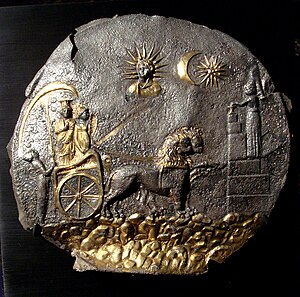Ai-Khanoum plaque

TheAi-Khanoum plaqueis an ancientGreco-Bactriandisk discovered at thearchaeologicalsite ofAi-KhanouminTakhar Province,Afghanistan.ThisHellenisticcity served as a military and economic center for the rulers of theGreco-Bactrian Kingdomuntil its destructionc. 145BC. Rediscovered in 1961, the ruins of the city were excavated by theFrench Archaeological Delegation in Afghanistan(DAFA) untilan outbreak of conflictin Afghanistan during the late 1970s. Among the structures excavated by the archaeologists was a sanctuary called the 'Temple of Indented Niches', (French: "temple à niches indentées"; alternatively "temple à redans", meaning 'Stepped Temple')[1]in which the disk was found. The disk is held in the collection of theNational Museum of AfghanistaninKabul.
This disk, depicting the Greek goddess Nike driving a chariot drawn by lions and accompanied by the Greek goddess Cybele, was described as "remarkable" by theMetropolitan Museum of Arton account of its "hybrid Greek and Oriental imagery".[2]Made of silver, the disk combines components of Greek culture, such as thechlamysall the deities wear, with Oriental designmotifssuch as the fixed pose of the figures and thecrescentmoon.[3]It has been described as "the most important work [of] the Greco-Oriental style".[4]
Details
[edit]The disk was excavated from one of the southern storage rooms of the Temple of Indented Niches during the 1969 DAFA excavation campaign. It had been hidden between the bases of two large jars against a wall.[5]It is made ofsilver,and engraved withgolddetails:[6]a figure normally identified as the Greek deityCybeletraverses a rocky landscape in a chariot pulled bylionsand guided by a winged goddess of Victory; meanwhile, one priest holds a parasol over Cybele, while another burns incense upon a stepped Oriental altar towards which the chariot travels. Above these figures are shown theSunasHelios,theMoon,and a star.[7][8]
The disk has been attested as an example of a blended Hellenistic and Oriental artistic style. DAFA's lead archaeologistPaul Bernardnoted that the iconographic elements—the representations of Victory and Helios, and the robes of the goddesses—were predominantly Greek in origin. However, the image displays no sense of perspective, with the characters displayed either in profile or head-on, which derives from Oriental tradition.[6][9]However, some aspects of the disk have been disputed, especially with regard to what it shows about Ai-Khanoum's religion.Claude Rapinbelieved that the disk in fact showed the Egyptian goddessIsis,not a Victory, whileHenri-Paul Francforttheorised that the disk displayed an actual religious event in the city.[10][11]
References
[edit]- ^Mairs 2013,p. 92, note 29.
- ^"Afghanistan: Hidden Treasures from the National Museum, Kabul".Metropolitan Museum of Art.Archivedfrom the original on 27 June 2017.Retrieved30 October2022.
- ^Bernard 1970,pp. 339–347.
- ^Bernard 1996,p. 116.
- ^Bernard 1970,p. 339.
- ^abBernard 1982,p. 158.
- ^Bernard 1996,pp. 116–117.
- ^Francfort et al. 2014,p. 59.
- ^Bernard 1996,pp. 117–118.
- ^Rapin 1990,p. 340.
- ^Francfort 2012,p. 125.
Sources
[edit]- Bernard, Paul(1970).Campagne de fouilles 1969 à Aï Khanoum en Afghanistan[1969 excavation campaign at Aï Khanoum in Afghanistan] (Report).DAFA.Retrieved14 November2022.
- Bernard, Paul(1982)."An Ancient Greek City in Central Asia".Scientific American.No. 246. pp. 148–159.JSTOR24966505.Retrieved21 April2022.
- Bernard, Paul(1996)."The Greek Kingdoms of Central Asia"(PDF).In Harmatta, János (ed.).History of civilizations of Central Asia.Vol. 2.Paris:UNESCO.ISBN9789231028465.
- Francfort, Henri-Paul(2012)."Ai Khanoum 'Temple with Indented Niches' and Takht-i Sangin 'Oxus Temple' in Historical Cultural Perspective: Outline of a Hypothesis about the Cults".Parthica(14).Pisa:109–136.
- Francfort, Henri-Paul;Grenet, Frantz; Lecuyot, Guy; Martinez-Sève, Laurianne; Rapin, Claude; Lyonnet, Bertille, eds. (2014).Il y a 50 ans... la découverte d'Aï Khanoum: 1964–1978, fouilles de la Délégation archéologique française en Afghanistan (DAFA)[50 years ago... the discovery of Aï Khanoum: the 1964–1978 excavations by the French Archaeological Delegation in Afghanistan (DAFA)] (in French). Vol. 35.Paris:Editions de Boccard.ISBN9782701804194.JSTORj.ctt1b7x71z.
- Mairs, Rachel (2013). "The 'Temple with Indented Niches' at Ai Khanoum: Ethnic and Civic Identity in Hellenistic Bactria". InAlston, Richard;van Nijf, Onno; Williamson, Christina (eds.).Cults, Creeds and Identities in the Greek City after the Classical Age.Leuven:Peeters Publishers.ISBN978-9042927148.
- Rapin, Claude (1990)."Greeks in Afghanistan: Ai Khanum".In Descœudres, Jean-Paul (ed.).Greek Colonists and Native Populations: Proceedings of the First Australian Congress of Classical Archaeology.Oxford:Clarendon Press.pp. 329–342.ISBN978-0-19-814869-2.
